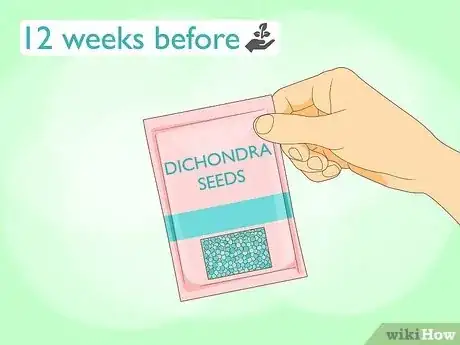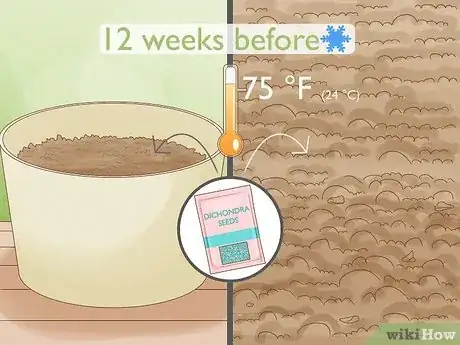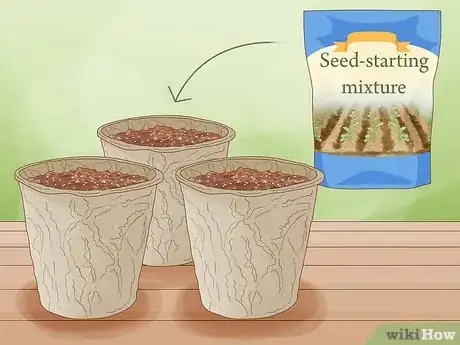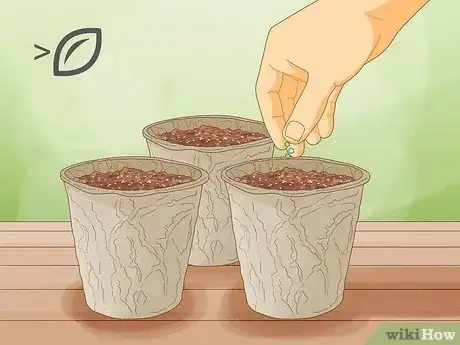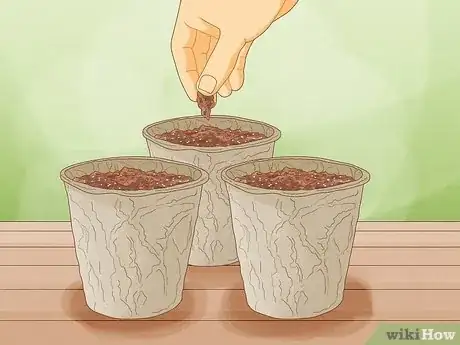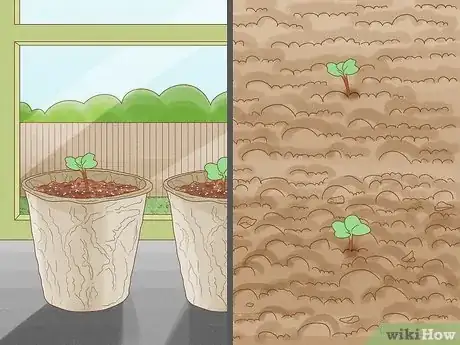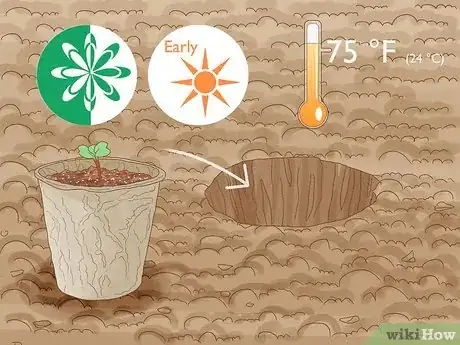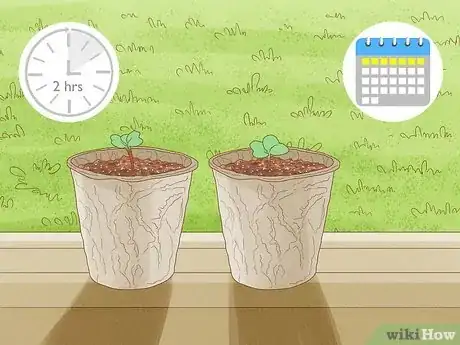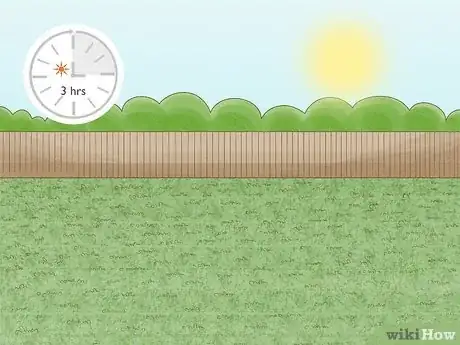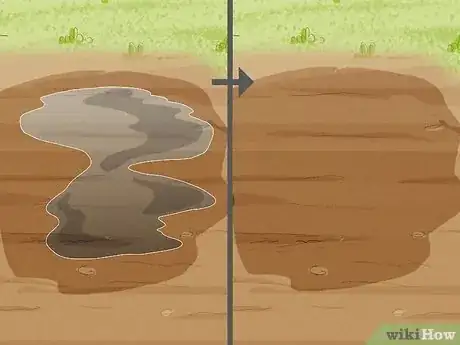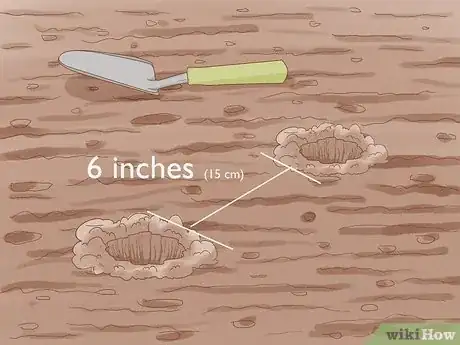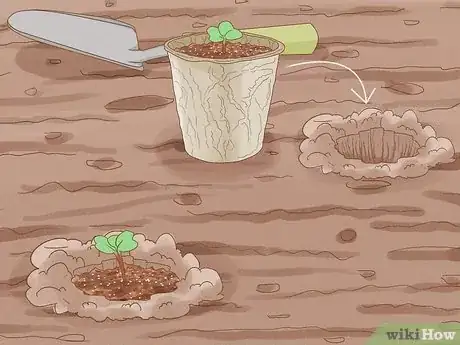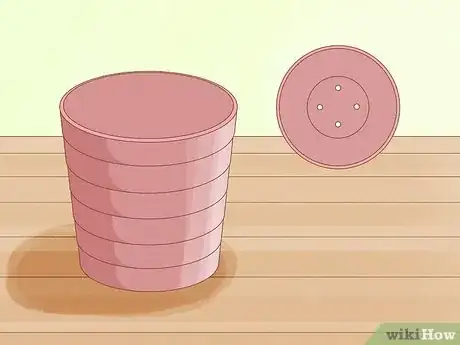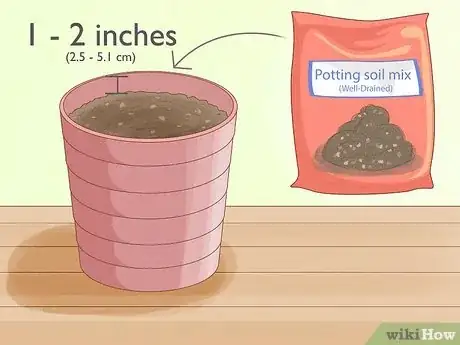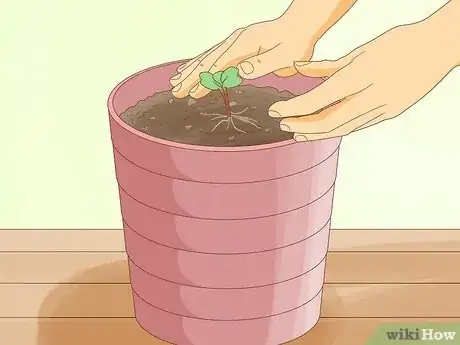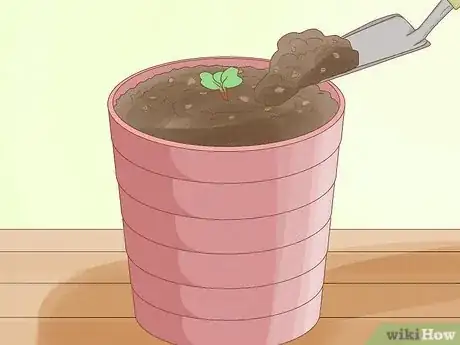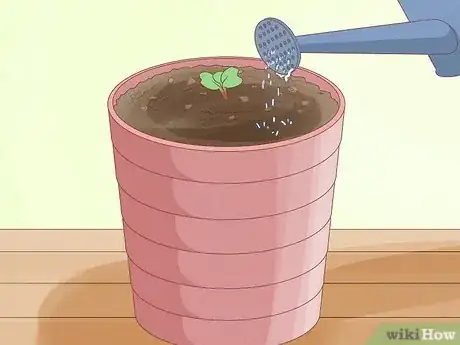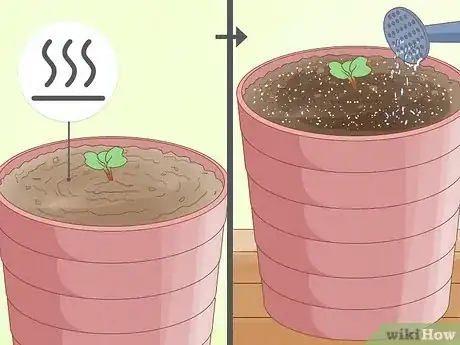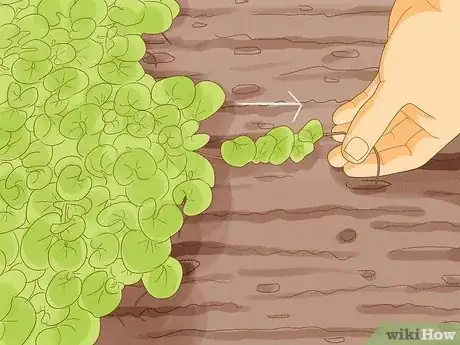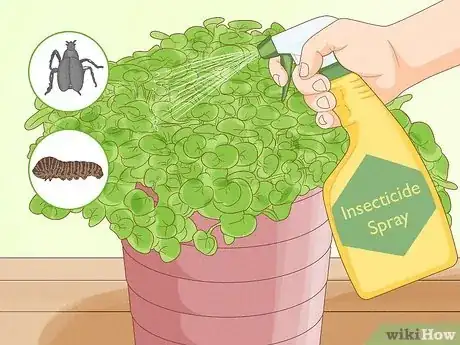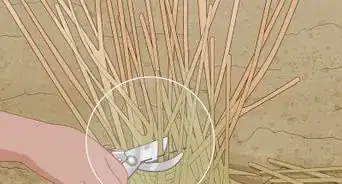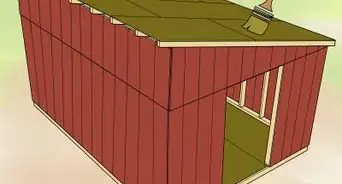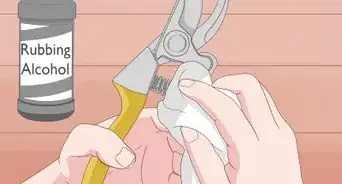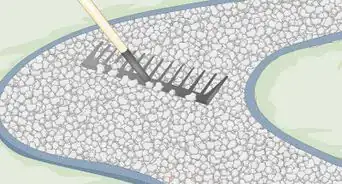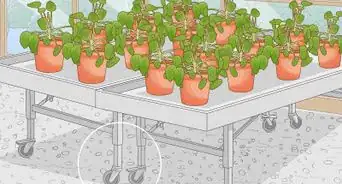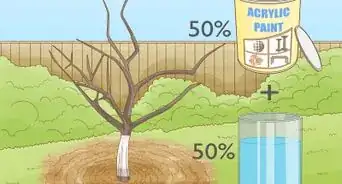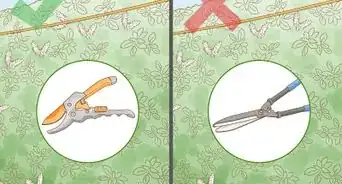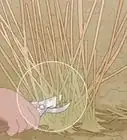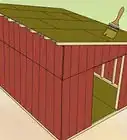This article was co-authored by Lauren Kurtz and by wikiHow staff writer, Danielle Blinka, MA, MPA. Lauren Kurtz is a Naturalist and Horticultural Specialist. Lauren has worked for Aurora, Colorado managing the Water-Wise Garden at Aurora Municipal Center for the Water Conservation Department. She earned a BA in Environmental and Sustainability Studies from Western Michigan University in 2014.
This article has been viewed 46,455 times.
Available in silver or green shades, dichondra makes a great ornament in any lawn or garden, if you live in a warm area. It’s an easy-to-grow option for either a groundcover or planter. You can grow dichondra as a perennial in warm climates or an annual in colder climates. If you plant it in the ground, it will beautifully carpet your yard or garden. In a planter, dichondra will spill out in a waterfall of lush leaves. Once seeds you’ve started begin to sprout, you can transplant them and care for beautiful plants in your garden.
Steps
Starting Dichondra Seeds
-
1Purchase seeds 12 weeks before you plan to transplant them outdoors. You’ll need this time to start your seeds. You can purchase your seeds from a garden store or online.[1]
- When seed shopping, opt for regular green dichondra seeds if you want ground cover.
- If you want a lovely cascading ornamental planting, choose silver falls or emerald falls dichondra. Both of these varieties will spill out of the container or bed where they’re planted. One is a grayish-silver color, while the other is green.
- Alternatively, you could purchase dichondra bedding plants from your local gardening store immediately before planting outdoors, which would allow you to skip starting seeds.
-
2Start the seeds indoors 12 weeks before the last frost. Dichondra thrive in a warm environment, so you’ll need to wait until spring or summer to plant them outdoors. Although you can plant the seeds directly into the ground, it’s easier to start them indoors. You’ll also see quicker results in your yard or garden!
- If you want to plant directly into the soil outdoors, wait until the temperature is consistently above 75 °F (24 °C).[2]
- If you live in the United States or Canada, you can find your last frost date by inputting your location into the Almanac's date calculator: https://www.almanac.com/gardening/frostdates
Advertisement -
3Fill starter pots ⅔ of the way with a well-draining soil. The soil should be loose, so don’t pack it down. Dichondra thrive in drier environments, so it’s important that the soil is not waterlogged around the seed or seedlings.[3]
- You could also start your seeds in a seed starter potting mix, which you can find at most gardening stores.
-
4Sprinkle a few seeds in each starter pot. It’s best to put more than 1 seed in each pot because not all of them will sprout. If they do all sprout, you can spread out the seedlings when you replant them or snip the weaker sprouts with scissors.[4]
-
5Cover the seeds with a light layer of soil. You don’t need to bury the dichondra seeds. They are more likely to sprout if the top layer of soil is thinner.[5]
- If you’re planting the seeds directly into the ground outdoors, you can scatter the seeds over your plot and then sprinkle a light layer of soil over them. You can use the existing soil if it’s ready for plantings or a well-draining soil purchased from a gardening store.[6]
-
6Place the seeds in a warm, sunny spot. The best place to put them is on a windowsill that gets sun throughout the day. Dichondra need warmth, so make sure the temperature of the room where they’re kept stays above 75 °F (24 °C).[7]
- For example, you could keep your dichondra seeds on your kitchen windowsill.
-
7Keep the soil moist while you wait for the sprouts to appear. Check the soil to see if it’s moist by touching the soil. If it’s dry, mist it with water. It will likely take 1 to 2 weeks for your seeds to sprout.[8]
- You may need to sprinkle water over the soil about 3 times a day, especially if they’re outside. Plan to mist your soil often, but make sure that you don’t see any standing water before you spray the plants.
- You can find a small spray bottle to mist the plants with at a garden store or online.
-
8Transplant your dichondra after 7-8 weeks. When they’re ready for transplant, you should see several leaves sprouting on the plants. You can replant them in either a pot or the ground, depending on your preference.[9]
-
9Wait until spring or early summer to plant outdoors. Dichondra grow best under warm conditions, so wait until spring is in full swing before your planting. If there’s a threat of cooler temperatures, it’s best to wait.[10]
- It's best to wait until the temperature is consistently above 75 °F (24 °C).[11]
-
10Harden off your plants by placing them outside for a few hours each day. Do this for 1 week before you plant them outside. Start with 2 hours outdoors each day, slowly extending the time the plants spend outdoors. This will prevent the plants from getting shocked when you place them outside.[12]
- Make sure that the seedlings are protected from the wind when they’re placed outside. You can protect them by placing them next to a wall, fence, or other structure that blocks part of the wind.
Transplanting Dichondra in the Ground
-
1Decide if you want a ground cover. Dichondra is a flexible plant that can be used as a plush covering for a flower bed or yard, or it can be used as an accent to your garden or home. Planted in the ground, dichondra will spread out, forming a lush carpet. It can form the base of your flower bed or replace grass. If you want a ground cover, you should prepare a spot in your yard.[13]
- This plant is a perennial in warm climates and will thrive as a ground cover or turf alternative in USDA hardiness zones 10-11.[14]
-
2Select a warm spot that gets at least part sun. Check your yard for an area that gets at least 3 hours of sun each day but it can be partially shaded. Dichondra thrive in partial to full sun. Shade can come from your home, a fence, a garden wall, or a similar large structure.[15]
- It’s a good idea to observe your yard every day for a week or 2 before you plant your dichondra. Go outside at different times of the day to see how sunny the spot is at that hour.
-
3Make sure the area has good drainage. You can check the drainage by observing the spot after it rains. If the soil drains well, then you shouldn’t see pooling water. This means the spot should be good for your planting.[16]
- If you do see pools of water, then the area does not have good drainage. It’s best to choose a different spot for your dichondra or amend your soil to improve the drainage. The easiest way is to raise your planting beds using loose, well-draining soil.[17]
-
4Break up your soil. This will improve the soil's drainage. Use a tiller, shovel, or spade to dig down 5 to 6 inches (13 to 15 cm) into the soil. Bust any clumps so that the soil will be loose around the roots, allowing water to flow away from them.[18]
- Dichondra thrives best in dry soil.
-
5Dig a hole large enough to cover the entire root system. Use a shovel or spade to remove the soil. It should be large enough for you to spread out the roots.[19]
- If you are planting more than one dichondra in the same plot, the holes should be spaced at least 6 inches (15 cm) away from each other.
-
6Place your plant in the hole. Make sure the roots are loose before you place the plant into the hole. The roots should also have room to spread out.[20]
- If your hole doesn’t seem large enough for the roots to spread out, then it’s best to dig a larger hole. Otherwise, your plant may not thrive.
- Plant the dichondra level with the top of the soil.
-
7Cover the plant with soil. The entire root system should be covered. However, don’t pack down the soil. Dichondra grow better in loose, well-draining soil.[21]
-
8Water the plant generously. Saturate the soil with water after you complete the transplanting. While you’ll water sparingly later, it’s important that they are well-watered after their initial planting.[22]
Transplanting Dichondra in a Pot
-
1Choose a pot if you want to accent your garden or home. When grown in a container, dichondra will spill over the sides like a waterfall. This makes it a great option for pots, window planters, and hanging planters. If you want an accent, you should prepare a container.[23]
- You can choose any size container, though the plant will thrive better in a medium to large container. Dichondra are often grown in window boxes or hanging baskets.
-
2Get a pot that has good drainage. A pot with good drainage will have holes at the bottom for the excess water to flow away from the root system. This prevents the water from saturating the roots, which can cause a fungus to grow on the plant.[24]
- If you don't want the excess water to stain the surface below the pot, then you can get a small planter dish that fits under the pot. This will catch the excess water. Some pots come with a drain dish attached to the pot.
-
3Fill your container with a well-draining potting soil. Your pot should be almost full, leaving 1 to 2 inches (2.5 to 5.1 cm) between the soil and the top of the pot. This reduces overflowing during watering. The soil should feel light and loose. For best results, select an organic potting mix, which you can easily find at a gardening store.[25]
- When you buy soil, make sure it’s labeled as potting mix and is not intended for use in a lawn.
-
4Place the plant into the potting mix. Spread out the roots before you place the plant into the soil. Make sure that the entire root system is within the pot. If it isn't, move aside some of the soil to bury the plant deeper.[26]
- If you're using small pots, it's best to stick with one seedling per pot. You can plant more seedlings in larger pots, though the plants may not grow to be as large. It's best to space them at least 6 inches (15 cm) apart.
- Dichondra can also be mixed in a pot with other plants, as long as the plants all have room to grow. They'll grow best if they're spaced at least 6 inches (15 cm) apart.
-
5Fill the rest of the pot with potting soil. The entire root system should be covered, and the stem should be supported by the soil. However, don't pack the soil firm, as the dichondra will thrive better in loose, well-draining soil.[27]
-
6Water the dichondra thoroughly. After you cover the roots, saturate the potting soil with water. Normally, dichondra should be watered sparingly. However, they need extra water when they're first transplanted.[28]
Caring for Dichondra
-
1Fertilize your dichondra monthly with nitrogen. Sprinkle the fertilizer over your dichondra before a scheduled watering, and then water your plants. The water will wash the fertilizer down into the soil, where it will be absorbed.[29]
- How much fertilizer you will need depends on your plot or container size. Follow the directions on your fertilizer to ensure you use the right amount.
- Don’t let the fertilizer rest on top of the leaves, as it could burn them.
-
2Let the soil dry out completely between waterings. Since dichondra prefer dryer conditions, overwatering them can cause them to die. Before watering the plants, check the soil to make sure it’s completely dry. To do this, simply feel the soil. It should feel dry and loose.[30]
- When you water the dichondra, provide at least 1 inch (2.5 cm) of water. It's okay to provide more if the conditions are very dry or if your soil has a lot of runoff.[31]
- If it’s dry, water the dichondra. If the soil feels wet, wait and check it again the next day.
- Watering too often can cause a fungus to grow on the plants.[32]
-
3Monitor the spread of the dichondra so that it doesn’t overtake the lawn. While it’s lovely, dichondra is also considered to be an invasive species in some areas. It will continue to grow and propagate itself until it takes over the entire yard. Keep the spread of the plant in check by pulling plants and their roots that grow outside the plot.
- If you think your dichondra has outgrown its container, you can transplant it. However, some people prefer to just prune it back using pruning shears.
-
4Use an organic or natural insecticide to prevent pests. The biggest threats are cutworms and flea beetles, both of which are easily prevented using an insecticide. Simply spritz your plants with the insecticide.[33]
- Follow all of the instructions on your insecticide to make sure you’re using it safely.
- If you'd like, you can make your own natural insecticide.
Expert Q&A
-
QuestionDoes dichondra need to be mowed?
 Lauren KurtzLauren Kurtz is a Naturalist and Horticultural Specialist. Lauren has worked for Aurora, Colorado managing the Water-Wise Garden at Aurora Municipal Center for the Water Conservation Department. She earned a BA in Environmental and Sustainability Studies from Western Michigan University in 2014.
Lauren KurtzLauren Kurtz is a Naturalist and Horticultural Specialist. Lauren has worked for Aurora, Colorado managing the Water-Wise Garden at Aurora Municipal Center for the Water Conservation Department. She earned a BA in Environmental and Sustainability Studies from Western Michigan University in 2014.
Professional Gardener Dichondra is not a grass. It doesn’t need to be mowed. To get a thicker mat of dichondra, it can be mowed short sparingly throughout the season.
Dichondra is not a grass. It doesn’t need to be mowed. To get a thicker mat of dichondra, it can be mowed short sparingly throughout the season. -
QuestionHow do I trim a potted silver dichondra?
 Lauren KurtzLauren Kurtz is a Naturalist and Horticultural Specialist. Lauren has worked for Aurora, Colorado managing the Water-Wise Garden at Aurora Municipal Center for the Water Conservation Department. She earned a BA in Environmental and Sustainability Studies from Western Michigan University in 2014.
Lauren KurtzLauren Kurtz is a Naturalist and Horticultural Specialist. Lauren has worked for Aurora, Colorado managing the Water-Wise Garden at Aurora Municipal Center for the Water Conservation Department. She earned a BA in Environmental and Sustainability Studies from Western Michigan University in 2014.
Professional Gardener Simply snip stems that are too long. Trim below a leaf node for a more manicured look or simply grab a bunch and trim to the desired length.
Simply snip stems that are too long. Trim below a leaf node for a more manicured look or simply grab a bunch and trim to the desired length. -
QuestionWhen should I start seeds indoors?
 NinoxTop AnswererYou should sow dichondra in April-May or October. This way, you avoid droughts and frost.
NinoxTop AnswererYou should sow dichondra in April-May or October. This way, you avoid droughts and frost.
Things You'll Need
- Dichondra seeds or bedding plants
- Well-draining soil
- Water
- Spade, shovel, and/or rake
- Tiller (optional)
- Spray bottle
- Nitrogen fertilizer
References
- ↑ https://wimastergardener.org/article/silver-falls-dichondra/
- ↑ https://wimastergardener.org/article/silver-falls-dichondra/
- ↑ https://www.bhg.com/gardening/plant-dictionary/annual/dichondra/
- ↑ https://wimastergardener.org/article/silver-falls-dichondra/
- ↑ https://wimastergardener.org/article/silver-falls-dichondra/
- ↑ https://northamericanfarmer.com/howtogrow/flowers/growing-dichondra/
- ↑ https://wimastergardener.org/article/silver-falls-dichondra/
- ↑ https://wimastergardener.org/article/silver-falls-dichondra/
- ↑ https://wimastergardener.org/article/silver-falls-dichondra/
- ↑ https://northamericanfarmer.com/howtogrow/flowers/growing-dichondra/
- ↑ https://wimastergardener.org/article/silver-falls-dichondra/
- ↑ https://www.almanac.com/content/transplanting-your-seedlings
- ↑ https://northamericanfarmer.com/howtogrow/flowers/growing-dichondra/
- ↑ https://www.bhg.com/gardening/plant-dictionary/annual/dichondra/
- ↑ https://www.bhg.com/gardening/plant-dictionary/annual/dichondra/
- ↑ https://www.bhg.com/gardening/plant-dictionary/annual/dichondra/
- ↑ https://www.bhg.com/gardening/landscaping-projects/landscape-basics/improve-poor-drainage/
- ↑ https://northamericanfarmer.com/howtogrow/flowers/growing-dichondra/
- ↑ https://www.almanac.com/content/transplanting-your-seedlings
- ↑ https://www.almanac.com/content/transplanting-your-seedlings
- ↑ https://www.almanac.com/content/transplanting-your-seedlings
- ↑ https://www.almanac.com/content/transplanting-your-seedlings
- ↑ https://www.bhg.com/gardening/plant-dictionary/annual/dichondra/
- ↑ https://www.bhg.com/gardening/plant-dictionary/annual/dichondra/
- ↑ https://www.bhg.com/gardening/landscaping-projects/landscape-basics/improve-poor-drainage/
- ↑ https://www.bhg.com/gardening/plant-dictionary/annual/dichondra/
- ↑ https://www.bhg.com/gardening/plant-dictionary/annual/dichondra/
- ↑ https://www.almanac.com/content/transplanting-your-seedlings
- ↑ https://northamericanfarmer.com/howtogrow/flowers/growing-dichondra/
- ↑ https://wimastergardener.org/article/silver-falls-dichondra/
- ↑ https://northamericanfarmer.com/howtogrow/flowers/growing-dichondra/
- ↑ https://northamericanfarmer.com/howtogrow/flowers/growing-dichondra/
- ↑ https://northamericanfarmer.com/howtogrow/flowers/growing-dichondra/
